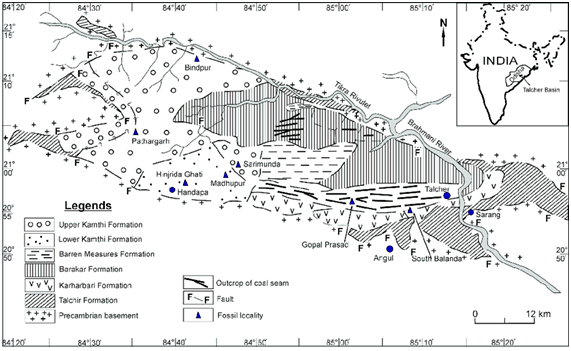Talchir Fm
Type Locality and Naming
[Figure 1: Geological map of Talcher Basin of Odisha after Manjrekar et al. (2006), Pal et al. (1991), Raja Rao (1983)]
Synonyms: Talchir Series (Jowett, 1925; Fox, 1930 a, b, c, d; Gee, 1932) (Source: Peters, 2009).
Lithology and Thickness
Glacial and glacial-marine. Ghosh and Mitra (1975) suggests deposition in type area in two cycles, each beginning with very coarse sediments, either tillites or conglomerates which are overlain by sandstone with thick band of varve clay followed by fine-grained sandstone at top with the section thickness varying between 23.5 m to 79 m. The Talchir Formation attains maximum thickness of about 240 m in the Jharia Basin.
Relationships and Distribution
Lower contact
Talchir Formation forming the base of the Gondwana sequence, rests over the Precambrian basement with a non-conformity.
Upper contact
Talchir Formation is unconformably overlain by the Karharbari Fm or Barakar Fm.
Regional extent
Talchir Formation has been recorded from almost all Gondwana basins in peninsular area including east coast, west Rajasthan, where it is known as the Bap Fm /Bhadura Fm and at Mingrimari in the western most Garo Hills, Meghalaya (Das Gupta and Biswas, 2000; Peters, 2009). It has also been encountered in Wells A-F (north of Ganga River) of Oil and Natural Gas commission, in parts of West Bengal (Thakur, 1993) and at Barapathar, Dhansiri Valley in Assam (Roy and Asthana, 1989).
GeoJSON
Fossils
Fossils from the Talchir Formation have been recorded from two levels, the lower Manendragarh Member / bed and the upper Umaria Member / bed, from several localities.
Manendragarh Member / bed has yielded Bryozoa - Protoretipora cf. ampla; Brachiopod- Spirifer hesdoensis; Pelecypod- Eurydesma hesdoensis, E. manendragarhensis, E. hobartense, E. playfordi, Aviculopecten squamulifermus, A. mitchelli; Gastropods - Euomphalus hesdoensis, E. cf. oculus, Pleurotomaria umariensis (Sahni and Dutta, 1962); Foraminifera -Hypermina gracilis, H. aff. bulbosa, H. sp cf. clevatula, Glomospira articulosa, Lituotuba? sp., Tolypommina polyvesta, Trochammina hesdoensis (Bhatia and Singh, 1959); Estheriid - Leaiidae (Ghosh et al. 1988); Ichnofossils- Skolithos, Cylindrichnus, Rosseelia, Teichhichnus, Rhyzocorallium, Scolicia and Cruziana. Ghosh et al. (1987); impressions of bodies and wings of arthropod and carbonized plant fragments (Source: Peters, 2009).
Umaria Member / bed contains Bryozoa - Rhombopora sp.; Brachiopods - Stepanoviella umariensis, S. umariensis var. spiriferous, S. rewahensis var. coroides, Ambikella barakarensis, Trigonatreta narsarhensis; Gastropods - Peruvispira umariensis, Janeia biarmica, Euomphalus sp.; Pelecypods- Eurydesma cf. mitiloides; Ostracods - Palaeocryoris sp., Cytherella sp., Jonesina sp., Jimbacrinus sp., Healdia umariensis (Reed, 1928; Sastry and Shah, 1964); Foraminifera -Hypermina gracilis and H. aff. elongata (Bhatia and Saxena, 1957; Bhatia, 1959). Plants fossils Gangamopteris and Neoggerathiopsis dominate. Other constituents are Cornucarpus furcata, Samaropsis goraiensis Walkomeilla indica and Paraanocladus ? indica (King, 1880; Feistmantel, 1886; Singh and Suresh,1951; Baksi, 1968; Chandra and Singh, 1994; Singh et al. 1998).
Plant fossils comprising Glossopteris longicaulis, equisetaceous stems, four species of Gangamopteris, Noeggerathiopsis hislopi, Arberia surangei, Ottokaria bengalensis, Vertebraria indica, four species of Gangamopteris, Noeggerathiopsis hislopi, Arberia surangei, Ottokaria bengalensis, Cardaicarpus seeds and Vertebraria indica have been reported from the Talchir Formation (Saxsena et al., 2014). Among playnofossils Late Asselian forms recorded are Potonieisporites, Parasaccites, Plicatipollenites, Gondwanapollis and Jayantisporites, whereas Early Sakmarian forms are Microbacultispora tentulata, M. foveolata, Tuberisaccites, Crucisaccites, Stellapollenites (Tiwari, 1996).
Age
Depositional setting
Facies analysis carried on Talchir section exposed along Dudhi nala, West Bokaro coalfield by Mukhopadhyay and Bhattacharya (1996) suggest a glacio-marine depositional environment for the Talchir Formation. The basin however was not under uniform cover of glacial ice or marine water as based on facies study of Talchir succession of Jharia Basin (Dasgupta 2006). The oldest sediments of Talchir Formation bear signature of glacial origin. They underwent brecciation possibly during deglaciation (Dasgupta 2006). The younger sediments were deposited during the terminal phase of the deglaciation event, which led to rise in the sea level and consequent marine flooding of the Indian continent.
Additional Information
References
Baksi, 1968; Bhatia, 1959; Bhatia and Saxena, 1957; Bhatia and Singh, 1959; Blanford et al. 1856; Chandra and Singh, 1994; Das Gupta and Biswas, 2000; Dasgupta 2006; Feistmantel, 1886; Fox, 1930 a, b, c, d ; Gee, 1932; Ghosh and Mitra, 1975; Ghosh et al. 1987, 1988; Peters, 2009; Jowett, 1925; King, 1880; Majrekar et al., 2006; Mukhopadhyay and Bhattacharya (1996; Pal et al., 1991; Raja Rao, 1983; Reed, 1928; Roy and Asthana, 1989; Sahni and Dutta, 1962; Sastry and Shah, 1964; Sastry et al. 1977; Saxsena et al., 2014; Singh and Suresh,1951; Singh et al. 1998; Tiwari, 1996; Thakur, 1993;
